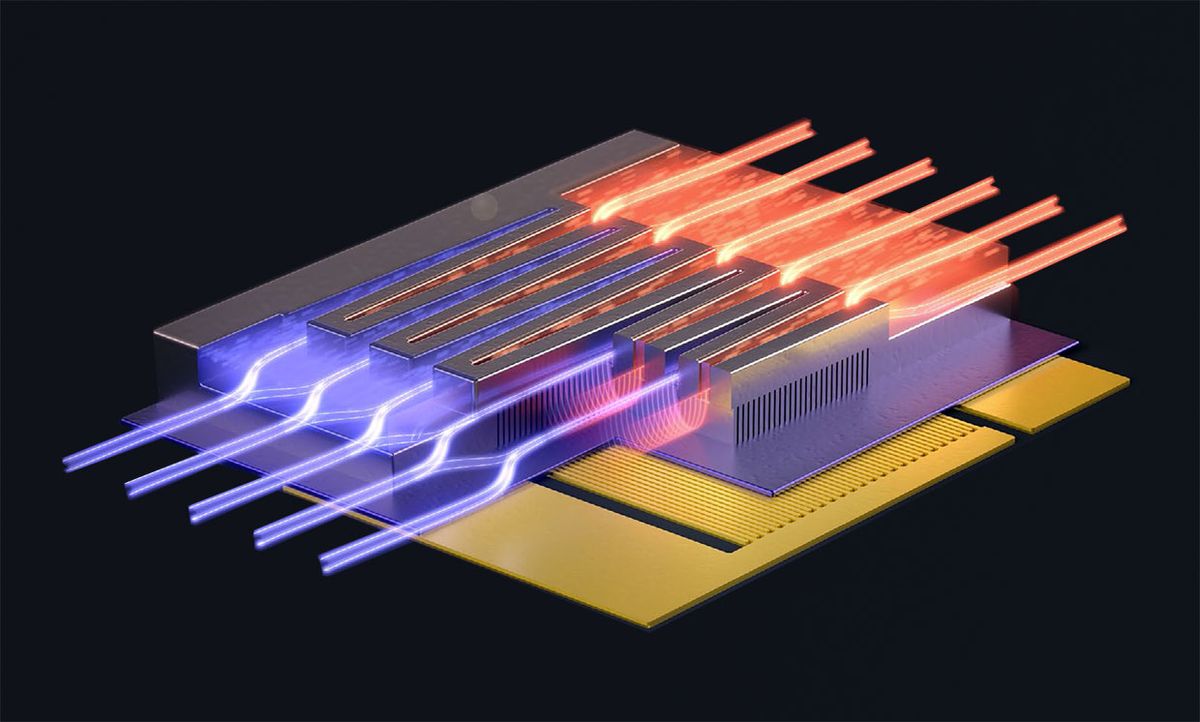The heat generated by today’s densely-packed electronics is a costly resource drain. To keep systems at the right temperature for optimal computational performance, data center cooling in the United States consumes the as much energy and water as all the residents of the city of Philadelphia. Now, by integrating liquid cooling channels directly into semiconductor chips, researchers hope to reduce that drain at least in power electronics devices, making them smaller, cheaper and less energy-intensive.
Traditionally, the electronics and the heat management system are designed and made separately, says Elison Matioli, an electrical engineering professor at École Polytechnique Fédérale de Lausanne in Switzerland. That introduces a fundamental obstacle to improving cooling efficiency since heat has to propagate relatively long distances through multiple materials for removal. In today’s processors, for instance, thermal materials syphon heat away from the chip to a bulky, air-cooled copper heat sink.
For a more energy-efficient solution, Matioli and his colleagues have developed a low-cost process to put a 3D network of microfluidic cooling channels directly into a semiconductor chip. Liquids remove heat better than air, and the idea is to put coolant micrometers away from chip hot spots.
But unlike previously reported microfluidic cooling techniques, he says, “we design the electronics and the cooling together from the beginning.” So the microchannels are right underneath the active region of each transistor device, where it heats up the most, which increases cooling performance by a factor of 50. They reported their co-design concept in the journal Nature today.
Researchers first proposed microchannel cooling back in 1981, and startups such as Cooligy have pursued the idea for processors. But the semiconductor industry is moving from planar devices to 3D ones and towards future chips with stacked multi-layer architectures, which makes cooling channels impractical. “This type of embedded cooling solution is not meant for modern processors and chips, like the CPU,” says Tiwei Wei, who studies electronic cooling solutions at Interuniversity Microelectronics Centre and KU Leuven in Belgium. Instead, this cooling technology makes the most sense for power electronics, he says.
Power electronics circuits manage and convert electrical energy, and are used widely in computers, data centers, solar panels, and electric vehicles, among other things. They use large-area discrete devices made from wide-bandgap semiconductors like gallium nitride. The power density of these devices has gone up dramatically over the years, which means they have to be “hooked to a massive heat sink,” Matioli says.
More recently, power electronics modules have turned to liquid cooling either via cold plates or micro channel cooling systems. But all microchannel cooling systems so far have been made separately and then bonded to the chip. The bonding layer adds heat resistance, and the channels and circuit devices aren’t aligned closely.
“We take it to the next level,” says Matioli, by making the device and cooling channels in the same chip. They etch micrometer-wide slits in a gallium nitride layer coated on a silicon substrate. The slits are 30µm-long and 115µm-deep. Using a special gas etching technique, they widen the slits in the silicon substrate to form the channels through which liquid coolant is pumped.
Then the researchers seal the tiny openings in the gallium nitride layer with copper, and make devices on top. “We only have microchannels on the tiny region of wafer that’s in contact with each transistor,” he says. “That makes the technique efficient because we can extract a lot of heat due to proximity but we use very little pumping power.”
As a demonstration, the researchers made an AC-to-DC rectifier circuit composed of four Schottky diodes, each capable of handling 1.2kV. A circuit like this would typically require a fist-sized heat sink and. But with the integrated liquid cooling system, the circuit chip sits on a USB stick-sized printed circuit board, which is made of three layers and has channels carved into it to deliver coolant to the chip.
They show that hot spots with power densities of over 1,700 watts per square centimeter can be cooled using only 0.57 W/cm2 of pumping power. That’s a 50-fold increase in performance compared to previously reported microfluidic channel cooling.
The reliability of the gallium nitride membranes and copper sealed layer should be investigated over time, Wei says. But this innovative cooling solution is a big step towards “low-cost, ultra-compact and energy-efficient cooling systems for power electronics.”
Prachi Patel is a freelance journalist based in Pittsburgh. She writes about energy, biotechnology, materials science, nanotechnology, and computing.



